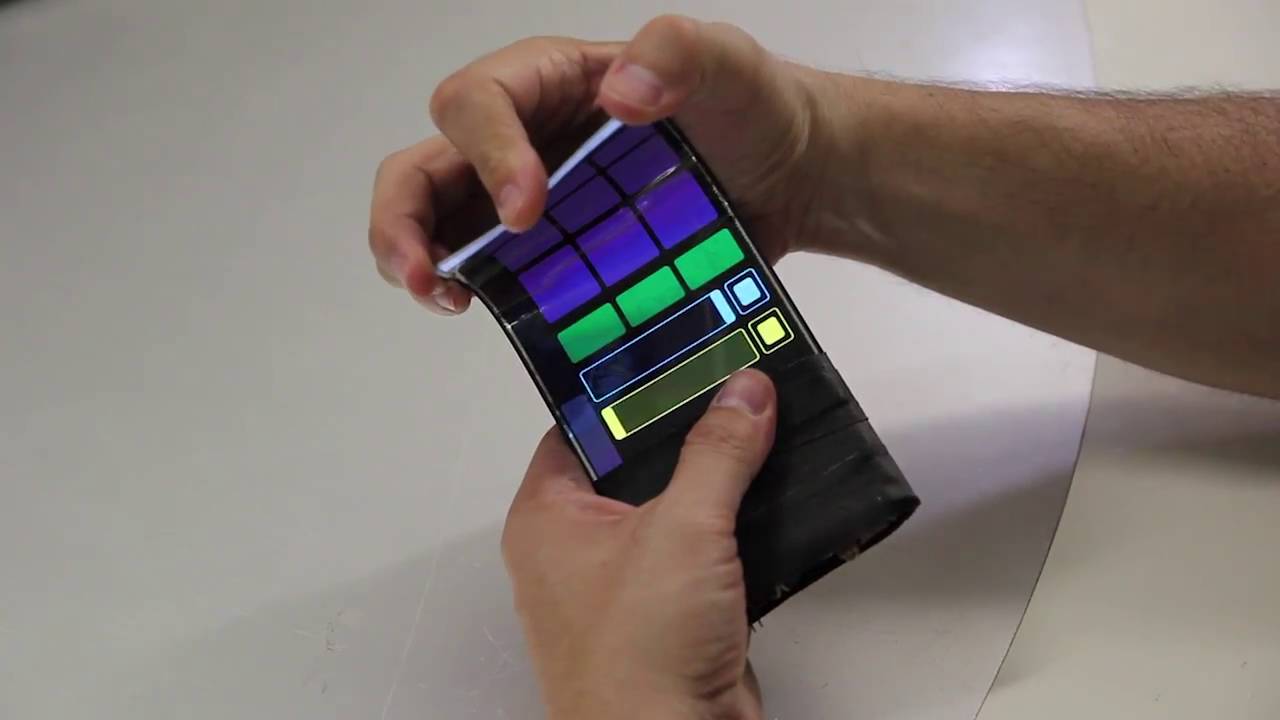Archive for the ‘mobile phones’ category: Page 194
Oct 20, 2016
Bendable WhammyPhone offers flexible music control
Posted by Shane Hinshaw in categories: computing, media & arts, mobile phones

Earlier this year, a team from Queen’s University in Canada demonstrated a smartphone prototype called ReFlex that had a flexible display capable of flipping virtual book pages in response to what were dubbed bend gestures. Researchers from the same Human Media Lab have now developed a similar device called the WhammyPhone that’s claimed to be the world’s first virtual musical instrument for flexible phones.
The WhammyPhone prototype sports a 1920 × 1080 pixel full high-definition Flexible Organic Light Emitting Diode (FOLED) touchscreen display and, like the ReFlex device, includes a bend sensor. This means that a user can manipulate the sound of electronically-generated instruments such as a guitar or violin by bending, squeezing or twisting the “smartphone.”
Continue reading “Bendable WhammyPhone offers flexible music control” »
Oct 20, 2016
A peek into the future of lithium batteries
Posted by Shane Hinshaw in categories: chemistry, mobile phones

In a great example of a low-cost research solution that could deliver big results, University of Michigan scientists have created a window for lithium-based batteries in order to film them as they charge and discharge.
The future of lithium-ion batteries is limited, says University of Michigan researcher Neil Dasgupta, because the chemistry cannot be pushed much further than it already has. Next-generation lithium cells will likely use lithium air and lithium sulfur chemistries. One of the big hurdles to be overcome in making these batteries practical is dendrites — tiny branch-like structures of lithium that form on the electrodes.
Continue reading “A peek into the future of lithium batteries” »
Oct 20, 2016
The key to better rechargeable batteries may be in your blood
Posted by Shane Hinshaw in categories: biotech/medical, mobile phones
Traditional lithium-ion batteries may be on the way out, as scientists continue to overcome the obstacles holding back the longer-lasting lithium-oxygen batteries. The main issue is lack of efficiency and the build-up of lithium peroxide, which reduces the electrodes’ effectiveness. But now a team at Yale has used a molecule found in blood as a catalyst that not only improved the lithium-oxygen function, but may help reduce biowaste.
Lithium-oxygen, or lithium-air batteries, have the potential to hold a charge for much longer than traditional lithium-ion batteries and extend the life of devices like phones to several weeks before they’d need to be recharged. But before those dreams can become a reality, the problems of efficiency and lithium peroxide build-up need to be solved.
Previous studies have tried to fight lithium peroxide by keeping the oxygen in the cell as a solid, and by modifying the electrode to produce lithium superoxide instead. In this case, the Yale researchers were looking for a new catalyst that allowed lithium oxide in the cell to decompose back into lithium ions and gaseous oxygen, and they found one in an unexpected place: animal blood.
Oct 18, 2016
Quantum Teleportation Could Revolutionize Modern Phone And Internet Communication
Posted by Karen Hurst in categories: encryption, finance, internet, mobile phones, quantum physics, space, transportation
I never get tired of articles highlighting the potential around leveraging Quantum teleporting as a method to replace networks and communications. Now the real question is how soon and how much of the existing infrastructure will need to be replaced to begin taking advantage of this technology earlier than others? As with most things, governments are often early adopters as well as Financial Services and ISPs are a close 2nd in the adoption of such technologies.
An experiment conducted about quantum teleportation could improve and transform the modern phone and Internet communication by having highly secure and encrypted messaging.
A recent study has suggested that comet outbursts are caused by avalanches and not geysers.
Oct 16, 2016
Flexible material puts full-color e-paper on display
Posted by Shane Hinshaw in category: mobile phones
E-ink displays may be easier on the eyes and less power-hungry than backlit LCDs used in most tablets and phones, but in the color department they’re still playing catch-up. However, this could change thanks to a new type of material developed at Chalmers University of Technology that is flexible, ultrathin and can produce the full color range of an LED-backlit LCD, but requires ten times less energy than a Kindle’s e-ink display.
Like a conventional e-reader screen, the material functions as a reflective display, so instead of being backlit like an LCD, the surface reflects the external light that hits it. Electrically conductive polymers covering the surface change how that light is absorbed and reflected, which allows it to recreate high resolution images and text. The end result is a material that’s less than one micron thick, flexible and extremely energy efficient.
“The ‘paper’ is similar to the Kindle tablet,” says Andreas Dahlin, lead author of the study. “It isn’t lit up like a standard display, but rather reflects the external light which illuminates it. Therefore it works very well where there is bright light, such as out in the sun, in contrast to standard LED displays that work best in darkness. At the same time it needs only a tenth of the energy that a Kindle tablet uses, which itself uses much less energy than a tablet LED display.”
Oct 16, 2016
No satellites needed for next-gen navigation system that uses “signals of opportunity”
Posted by Shane Hinshaw in categories: encryption, internet, military, mobile phones, robotics/AI, satellites

The Global Positioning System (GPS) is a great navigation aid – unless you lose the signal while negotiating a complicated spaghetti junction. That’s bad enough for conventional cars, but for autonomous vehicles it could be catastrophic, so the University of California, Riverside’s Autonomous Systems Perception, Intelligence, and Navigation (ASPIN) Laboratory under Zak Kassas is developing an alternative navigation system that uses secondary radio signals, such as from cell phone systems and Wi-Fi to either complement existing GPS-based systems or as a standalone alternative that is claimed to be highly reliable, consistent, and tamper-proof.
Today, there are two global satellite navigation systems in operation, the US GPS and the Russian GLONASS, with the European Galileo system set to become fully operational in the next few years, and plans for the Chinese Beidou system to extend globally by 2020. These have revolutionized navigation, surveying, and a dozen other fields, but GPS and related systems still leave much to be desired. By their nature, GPS signals are weak and positions need to be confirmed by several satellites, so built up areas or mountainous areas can make the system useless. In addition, GPS signals can be deliberately or accidentally jammed or spoofed due to insufficient encryption and other protections.
Oct 15, 2016
Teleporting Toward a Quantum Internet
Posted by Karen Hurst in categories: encryption, internet, mobile phones, quantum physics
New experiments in Calgary tested quantum teleportation in actual infrastructure, representing a major step forward for the technology.
Quantum physics is a field that appears to give scientists superpowers. Those who understand the world of extremely small or cold particles can perform amazing feats with them — including teleportation — that appear to bend reality.
The science behind these feats is complicated, and until recently, didn’t exist outside of lab settings. But that’s changing: researchers have begun to implement quantum teleportation in real-world contexts. Being able to do so just might revolutionize modern phone and Internet communications, leading to highly secure, encrypted messaging.
Oct 14, 2016
Engineering a Better Body and the End of Disease
Posted by Shailesh Prasad in categories: biotech/medical, computing, engineering, health, mobile phones, neuroscience, policy
There are two kinds of people in Washington, DC, says entrepreneur Dean Kamen. There are the policy experts, whom he calls cynics. And there are the scientists, whom he deems optimists.
Kamen, speaking at the White House Frontiers Conference at the University of Pittsburgh, places himself in the latter camp. Unlike policy wonks and politicians who see diseases like Alzheimer’s or ALS as unstoppable scourges, Kamen points out that previously terrifying diseases were all toppled by medical innovation. The plague, polio, smallpox — all were civilization-threatening epidemics until experimental scientists discovered new ways to combat them.
If that sounds like the kind of disruption that the tech industry has unleashed across the rest of the world, that’s no accident. Kamen, the founder of DEKA, a medical R&D company, says that the same trends that have empowered our computers and phones and communication networks will soon power a revolution in health care. He says that medical innovation follows a predictable cycle. First we feel powerless before a disease. Then we seek ways of treating it. Then we attempt to cure it.
Continue reading “Engineering a Better Body and the End of Disease” »














